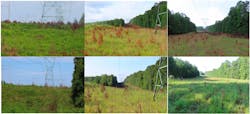Preventing trees and various brush species from interfering with utility infrastructure requires sound vegetation management strategies to prevent issues before they become threats. Many options for brush control exist, but there are clear trade-offs between the most common methods.
In the past, vegetation managers relied on mechanized mowing and trimming to control undesirable trees and brush species. The problem with these control methods is that they are nonselective, meaning that while they’re effective at controlling incompatible vegetation, they also decimate native plant communities. Native plants enhance the development of biodiverse ecosystems and provide a natural barrier against the reestablishment of unwanted trees and brush. That’s why using selective herbicide applications and grass-friendly brush mixes have quickly become preferred alternatives for utility companies working to enhance not only electrical transmission reliability but also environmental safety.
Research Supporting Selective Control
Nonselective control methods stimulate regrowth and the spread of viable seed. As incompatible stems develop, vegetation managers have to commonly re-treat right-of-way (ROW) corridors, which only increases long-term maintenance costs. Comparatively, selective herbicide applications and grass-friendly brush mixes enhance the development of native plant communities, eliminating areas where unwanted brush species can develop. This greatly reduces annual maintenance requirements and provides significant cost savings to ROW management programs.
In fact, the State Game Lands 33 (SGL 33) Research Project — which has studied the impact of different vegetation management strategies throughout utility rights-of-way for more than 65 years — has shown that these results can lower viable woody brush seed germination by as much as 88%, which reduces incompatible stem populations and maintenance requirements over time.
As a partner of the SGL 33 Research Project and manufacturer of solutions supporting the utility vegetation management industry, Corteva Agriscience provided supplemental support to grass-friendly brush control programs last year when it introduced TerraVue® herbicide to market. Safe on grass and most beneficial forbs, TerraVue is powered by Rinskor® active, a reduced-risk herbicide that won the American Chemical Society’s Green Chemistry Challenge Award. When tested as a tank-mix partner with Vastlan® herbicide on utility rights-of-way in Georgia last year, the selective brush mix was shown to provide outstanding results just 90 days after treatment. These results have quickly positioned TerraVue and Vastlan as the preeminent mix for selective brush management.
Another industry resource that supports the use of selective herbicide treatments throughout utility ROW corridors is The Cost-efficiency of IVM report by John W. Goodfellow. The report details how adapting integrated vegetation management (IVM) strategies featuring selective herbicides can significantly lower incompatible stem densities over a 20-year period to provide considerable cost savings to utility vegetation management programs.
Perhaps more important, these sustainable results also provide environmental benefits by enhancing wildfire mitigation programs and the development of biodiverse ecosystems that provide beneficial habitat to various wildlife species.
Additional Benefits of Grass-friendly Brush Control
Animal pollinators support the reproduction of approximately 35% of the world’s food crops (Natural Resources Conservation Service). However, as native flowering plants, host plants and nesting sites disappear with the establishment of incompatible vegetation, so do the pollinators. A loss of habitat has significantly lowered pollinator populations in recent years, presenting environmentally minded utility companies with the opportunity to leverage millions of ROW acres as sites that not only enhance electrical transmission reliability but also the conservation of habitat for pollinators and a variety of other wildlife species.
Supporting the development of biodiverse habitat consisting of grasses, herbs and small shrubs also allows IVM programs featuring selective herbicides to mitigate the risk of wildfires. As areas composed of perennial grasses and forbs do not significantly contribute to a fire’s intensity, these low-growing plant communities provide a landscape of fire-resistant plant species that help to impede a wildfire’s spread.
The California Department of Forestry and Fire Protection recently shared results from a 5-year study, which showed that one in every 10 wildfires is caused by electrical power. Establishing fuel breaks throughout utility rights-of-way can curb this alarming trend as they reduce ignition threats and provide a safe area for firefighters to effectively suppress wildfires and prevent them from spreading to nearby communities.
Pursuing Sustainability
At the end of the day, what’s good for the land also can be good for business. Grass-friendly brush control programs can effectively safeguard utility infrastructure, enhance the development of biodiverse habitat and provide significant cost savings to utility vegetation management programs. To learn more about using selective herbicides for sustainable results and the environmental benefits they provide to utility companies, wildlife and surrounding communities, visit HabitatWithHerbicides.com.
™ ® Trademarks of Corteva Agriscience and its affiliated companies. Rinskor® is a registered active ingredient. Under normal field conditions, TerraVue® is nonvolatile. TerraVue has no grazing or haying restrictions for any class of livestock, including lactating dairy cows, horses (including lactating mares) and meat animals prior to slaughter. Label precautions apply to forage treated with TerraVue and to manure and urine from animals that have consumed treated forage. TerraVue and Vastlan are not registered for sale or use in all states. Contact your state pesticide regulatory agency to determine if a product is registered for sale or use in your state. Consult the label for full details. Always read and follow label directions. © 2021 Corteva.
Sponsored by:

